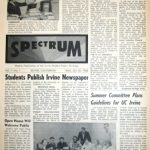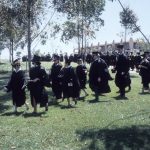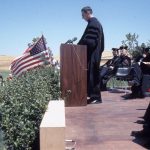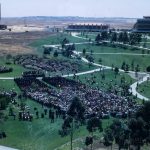UCI’s student newspaper went through several changes before becoming The New University in September 1968. The first student paper was Spectrum, which lasted from October 20, 1965 to January 27, 1966. Without University support, students formed a non-profit corporation to publish the paper. Next was the rival publication, Tongue, which published five issues between February and May 1966 and used the motto “The Windy Satisfaction of the Tongue” – a quote from The Odyssey of Homer. In the second year of the University came a third student newspaper called Anthill, which lasted for 32 issues published between October 6, 1966 and May 31, 1968. The New University continues to this day, housed in the same offices where it started in September 1968.
Early UCI Campus
Robert Cohen and “The Madwoman of Chaillot” on May 28, 1969
The Robert Cohen Festival takes place the weekend of October 28-29 at the Claire Trevor School of the Arts to honor  the Claire Trevor Professor of Drama Robert Cohen, celebrate his many contributions to the School, and dedicate a theatre named after him. Professor Cohen has had an amazing career here at UCI, with responsibility for numerous extraordinary productions. Among the most unusual was the May 28, 1969 production of “The Madwoman of Chaillot,” which took place during a period when all U.C. campuses, and campuses across the United States, were essentially closed down during massive campus strikes and protests against the Vietnam War. Professor Cohen, his cast and crew decided to continue the play, rather than cancel it in support of the strike. Robert Cohen read this moving message, justifying their decision, to the audience before each production. Thank you, Robert Cohen, congratulations on your many accomplishments and enjoy the upcoming weekend!
the Claire Trevor Professor of Drama Robert Cohen, celebrate his many contributions to the School, and dedicate a theatre named after him. Professor Cohen has had an amazing career here at UCI, with responsibility for numerous extraordinary productions. Among the most unusual was the May 28, 1969 production of “The Madwoman of Chaillot,” which took place during a period when all U.C. campuses, and campuses across the United States, were essentially closed down during massive campus strikes and protests against the Vietnam War. Professor Cohen, his cast and crew decided to continue the play, rather than cancel it in support of the strike. Robert Cohen read this moving message, justifying their decision, to the audience before each production. Thank you, Robert Cohen, congratulations on your many accomplishments and enjoy the upcoming weekend!
MS-P069. Robert Cohen Papers. Special Collections and Archives, the U.C. Irvine Libraries, Irvine, California.
Samoan canoe in Social Science Tower
Have you ever wondered where the canoe in the Social Science Tower came from?  It was actually made on the UCI campus in 1968 by an experienced Samoan boat-builder. The 36-year old man was from the village of Satalo on the island of Upolu, Western Samoa. His family had a long history of expertise in carpentry, and he was an experienced boat-builder and fisherman. Known as UliUli, he held the chiefly title Uliulileave, and he had spent his entire life on the island of Satalo before coming to UCI.
It was actually made on the UCI campus in 1968 by an experienced Samoan boat-builder. The 36-year old man was from the village of Satalo on the island of Upolu, Western Samoa. His family had a long history of expertise in carpentry, and he was an experienced boat-builder and fisherman. Known as UliUli, he held the chiefly title Uliulileave, and he had spent his entire life on the island of Satalo before coming to UCI.
AS-061. University Communication Photographs. Special Collections and Archives, the U.C. Irvine Libraries, Irvine, California.
There are 3 motion pictures from the University of California, Irvine, Department of Anthropology documenting the construction and use of a canoe by Uliulileave from Satalo, Samoa, as well as the work of a master Yucatec Maya potter named Alfredo Tzum. For more information on these films, visit UCI Space.
UPDATE: We are sorry to report that Uliuli passed away on January 25, 2015. More information is available here —
https://ucisca.wordpress.com/2016/02/02/the-passing-of-taloolemaagao-uliulileava-olano-the-great-samoan-canoe-builder/
John Van Hamersveld’s poster for “Faculty ’68” exhibition at the UCI Art Gallery
John Van Hamersveld is one of the best known and most prolific poster artists of the last 50 years. He did the design of the iconic poster for Bruce Brown’s film Endless Summer; album covers for the Beatles Magical Mystery Tour and the Rolling Stones Exile on Main Street; the official poster for the 1984 Los Angeles Olympic Games; the poster for the reunion concert of Cream at Royal Albert Hall in 2005; and numerous other important posters. In 1968, he also did the poster for the Faculty ’68 exhibition in the UCI Art Gallery. The exhibition, featuring works of then UCI Studio Art faculty Vija Celmins, Tony DeLap, Robert Irwin, Craig Kaufman, and Richard Smith, ran from April 16- May 5, 1968. 
AS-050. University of California, Irvine, Poster Collection. Special Collections and Archives, the U.C. Irvine Libraries, Irvine, California.
Jerry McMillan’s design for the exhibition catalog for “Faculty ’68”
Los Angeles artist Jerry McMillan designed the catalog for the “Faculty ’68” exhibition at the UCI Art Gallery in the spring 1968. McMillan was a childhood friend of artist Ed Ruscha and musician and song writer Mason Williams, growing up in Oklahoma City. After high school, the three friends drove to Los Angeles, following the iconic route 66 west. McMillan and Ruscha were roomates in an apartment in Hollywood while they attended Chouinard Art Institute. McMillan worked in advertising design initially, then moved to photography and “photosculpture.” He was the first photographer to have a one-person exhibition at the Pasadena Art Museum, in 1966. In 2004, he had solo exhibitions “Picturing Ed: Jerry McMillan’s photographs of Ed Ruscha, 1958-1972” in Santa Monica and Cologne, Germany.
Faculty, ’68; [Exhibition] April 16 through May 5, 1968. http://antpac.lib.uci.edu/record=b1231651~S7
UCI’s 3rd Commencement: June 15, 1968
UCI’s 46th commencement ceremonies will take place this weekend, June 10-12, and will include numerous commencement exercises and events, but in 1968 there was only one on June 15, 1968. The commencement speaker was Dr. Louis Benezet, then President of the Claremont University Center (now the Claremont University Consortium). His speech was titled “Who Shall Lead Us?” There were approximately 400 graduates in the 1968 commencement, there will be many more this weekend. Congratulations to all 2011 graduates!
AS-061. Communications Photographs. Special Collections and Archives, the U.C. Irvine Libraries, Irvine, California.
Radio Station KUCI 89.9 FM
KUCI began broadcasting, initially as an illegal pirate radio station, in 1968. Led by UCI student Richard Privette, KUCI broadcast from a dormitory and barely reached all of the campus. KUCI was granted its broadcast license on November 25, 1969, transmitting 10 watts of power at 89.9 FM. The first news broadcast occured in 1972, and the station began broadcasting 24 hours a day in 1974. KUCI moved from its original frequency of 89.9 fm to its current frequency of 88.9 fm on August 20, 1981. Below are a few photographs of the “station,” taken on February 22, 1974.
AS-061. University Communication Photographs. Special Collections and Archives, the U.C. Irvine Libraries, Irvine, California.
UCI Site Selection — Was This the First Choice?

Signing of agreement for campus site on July 22, 1960. Sitting at the table are UC President Clark Kerr (right) and UC Regent Ed Pauley (left).
On June 19, 1958, the Regents’ Site Selection Committee met to hear architect William Pereira present a large number of potential sites for the location of the UCI campus. The Irvine Ranch was one of the four finalists considered in Orange County and the one Pereira considered to be the best. However, the Regents’ first choice was a site in Newport Beach on the slopes of what is now known as Spyglass Hill, near the current location of Fashion Island. The site had a beautiful view of the coast and Catalina Island. While discussions of the proposed site were occurring, land at the center of the site was sold to the Pacific View Memorial Park cemetery. Joan Irvine Smith offered the cemetery an alternative site, including access to a water supply, a needed road, and an equally amazing view. However, Pacific View remained committed to their site. Due to the fact that several burials had occurred in the meantime, the cemetery’s original choice became secured. The second choice for the UCI campus was on the Irvine Ranch, and it was that site that was eventually selected.
AS-090. Agreements Between UCI and Irvine Company. Special Collections and Archives, the U.C. Irvine Libraries, Irvine, California.
Reagan Protest on January 23, 1967
On January 23, 1967, three days after UC President Clark Kerr was fired by the University of California Regents, 1500 UCI students, faculty and staff participated in the first organized UCI campus protest. The protests were directed at then Governor Ronald Reagan and the UC Regents. Reagan made an effort to raise student fees and had organized against Kerr. Here are some additional photographs of that protest.
More about “Conquest of the Planet of the Apes” filmed at UCI in 1972
“Conquest of the Planet of the Apes,” the fourth in the five-film “Planet of the Apes” series, was filmed at UCI in 1972. Much of the film, including the opening sequence, was filmed outside of Social Science Tower. In the film the ape Caesar, son of the late simians Zira and Cornelius (and played by Roddy McDowall), leads the apes to a revolution against humans. Dogs and cats have been wiped out by a plague, and humans (led by Governor Breck, played by Don Murray) have domesticated the apes and are treating them like slaves. Zira and Cornelius were murdered twenty years before because they had the ability to think and speak, but Caesar was spared. He works for and is protected by the circus keeper Armando (played by Ricardo Montalban). The protest and demonstration scenes, in which Caesar leads the apes in an attempt to overthrow the humans, were filmed at the University Administration building. The film originally had a darker, more violent opening and ending. Test audiences had a negative reaction to the original ending, and changes were made in the final version. Even with those changes, the film was the only film in the series that didn’t receive a G rating, it received a PG rating.
[slideshow]
AS-061. University Communications Photographs. Special Collections and Archives, the U.C. Irvine Libraries, Irvine, California.
See more about the film (including the trailer) at IMDb.















